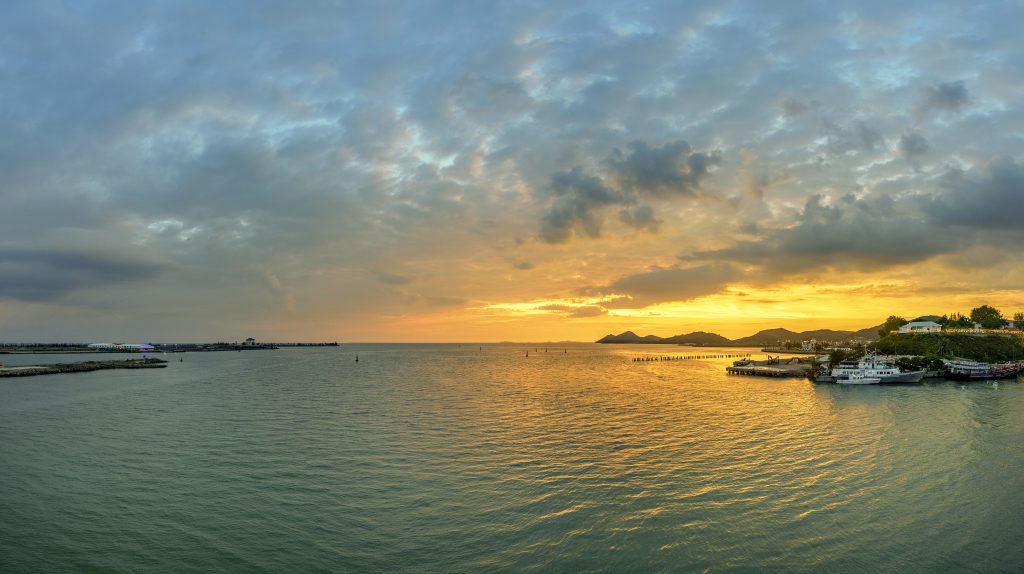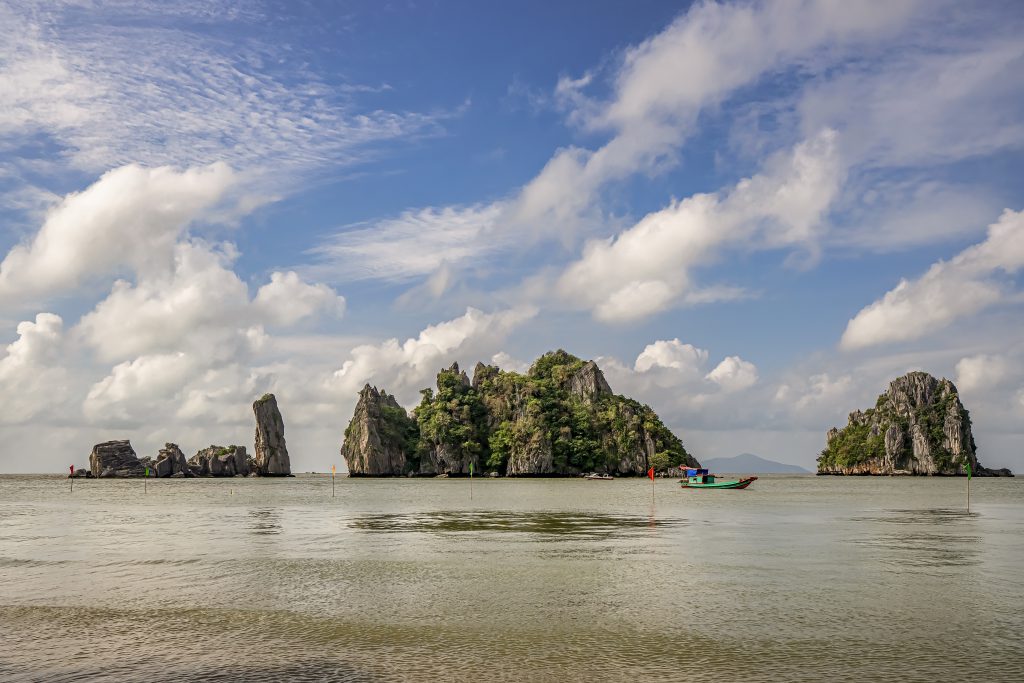Nam Hoa
Ha Tien, the country’s southwestern frontier, was settled and developed by Mac Cuu (1655-1735) in the mid-17th century and further expanded into a vast region by his son Mac Thien Tich (1718 – 1780). At the end of the 17th century, the town of Ha Tien was a small yet bustling and beautiful port town. Ha Tien’s famous landmarks were immortalized in the poetry collection “Ha Tien Thap Canh” (Ten Scenes of Ha Tien) by Mac Thien Tich.

At the dawn of the 20th century, the poet and cultural writer Dong Ho described Ha Tien as a remote area that was home to a wealth of beautiful spots to rival those in other regions. He praised limestone mountains like those in Ninh Binh; deep perilous caves akin to ones in Lang Son; stalagmites like of those in Huong Tich Cave; lakes akin to Hanoi’s West Lake; scenes like Hue’s Huong River; traces of pagodas like those in Bac Ninh; and seascapes that evoked Ha Long or Nha Trang. He wrote: “There are no grand complete landscape here, just small and delicate ones. Yet every type of scenery is present.”
In Ha Tien, I greet the new day in a city park by the banks of the Dong Ho Lake. The early morning breeze gently ripples the water’s surface, while the peaks of the To Chau Hills remain veiled in darkness, standing starkly against the dawn sky. The first rays of sun from behind To Chau splash across the sky, illuminating the white clouds against the sky’s blue canvas and crafting a portrait of nature’s tranquility.
Ascending Phao Dai (Fortress) Mountain, I stop to enjoy a cup of morning coffee and admire the expansive vista at the mouth of the Giang Thanh River. The small mound at the head of To Chau Bridge – once an island in the estuary of the Giang Thanh River but now merged with the mainland – is one of the ten renowned beautiful landscapes immortalized by the poetry of Mac Thien Tich. A notable figure in the era of the Nguyen Lords and a pioneer of the Ha Tien region, Mac Thien Tich described this island as “Kim Du lan dao”, which translates as “the golden island shielding Ha Tien from winds and storms”.
After finishing my coffee, I follow Highway 80 – the main artery of the city – to the outskirts, toward Thach Dong Mount. Nestled beside Highway 80, this isolated limestone peak stands nearly 100 meters tall. Within the mountain is a vast cave with many entrances. The natural stalactites form bizarre shapes, which have inspired local legends about the hero Thach Sanh. Sometimes, in the early mornings, clouds as white as cotton float languidly across Thach Dong Mount and get sucked into the cave’s mouth, as if the mountain were swallowing the clouds. This magnificent sight is the origin of the name “Thach Dong thon van” (Stone Cave Swallows Clouds), another of the ten beauty spots listed in “Ha Tien Thap Canh”.
About 2km from Thach Dong Mount, along the border with Cambodia, another famous attraction looms: Da Dung Mountain. Mac Thien Tich mentioned this mountain in his poem “Chau Nham lac lo” (Storks Return to Pearl Mountain). Midway up Da Dung Mountain lies a cave, which, according to legend, was Thach Sanh’s childhood home. After using a bow and arrow to shoot a giant eagle that had carried off a princess, Thach Sanh followed the trail of blood and found the eagle’s cave on nearby Thach Dong Mount. While it isn’t large, Da Dung Mountain is renowned for its rich system of caves, which have evocative names like Me Sanh [Sanh’s Mother’s] Cave, Thac Bac [Silver Waterfall] Cave, Cong Troi [Heaven’s Gate] Cave, Trong Nguc [Chest Drum] Cave, Kho Qua [Bitter Melon] Cave, and Kim Quy [Golden Turtle] Cave, etc.

Other scenic spots mentioned in “Ha Tien Thap Canh” include “Binh San diep thuy” (Serene Spectacle of Binh San Mountain), now home to the mausoleum of the renowned Mac family. It is impossible to speak of Ha Tien without mentioning the Mac clan, founded by Mac Cuu, who transformed this barren land into a bustling, wealthy port city on the Gulf of Siam (as the Gulf of Thailand was once known) and took the initiative to return Ha Tien to Dang Trong (Inner Circuit/Southern Vietnam) in 1708, during the reign of Lord Nguyen Phuc Chu. Surrounding the foot of Binh San Mountain are several ancient pagodas, including Sac Tu Tam Bao Pagoda, listed in Mac Thien Tich’s book as “Tieu tu than chung” (Morning Bell at the Deserted Tieu Pagoda). Ravaged by time and warfare, Sac Tu Tam Bao Pagoda has been almost entirely rebuilt. Despite having been renovated, the nearby pagoda of Phu Dung retains the elegant air of an ancient pagoda.
About 35 kilometers from central Ha Tien town lie Phu Tu Islet and the scenic Hang Pagoda. I took the coastal route, accompanied by refreshing breezes imbued with a salty tang. I passed beneath towering ancient trees whose green canopies cast cool shadows on the winding road. Hang Pagoda is the vernacular name for Hai Son Pagoda, a Buddhist place of worship nestled in a natural cave by the sea. Adorned with stalactites of various shapes, it reminded me of a miniature Phong Nha Cave. On stepping out of the cave, one reaches the beach, which offers views of what’s left of Phu Tu Islet – a longtime symbol of tourism in Kien Giang. In the past, Phu Tu Islet was comprised of two towering rocks that stood side by side on a shared base, rising above the sea. Regrettably, in 2006, the rock known as “Phu” collapsed into the sea, leaving “Tu” to stand alone.
Last but not least, I wish to describe the sunset at Mui Nai, listed by Mac Thien Tich as “Loc Tri thon cu” [Standing Deer Residence]. Located to the southwest of Ha Tien, this promontory juts into the sea, resembling the head of a deer with its muzzle pointing seaward, hence the name Mui Nai, which translates as “Deer’s Nose”.
As the sun gradually sunk into the serene western sea it resembled an orange. The light slowly faded into the evening breeze, reminding me of the gentle melody of the song “Ha Tien” by the musician Minh Ky:
“Tôi nhớ hoài một chiều dừng chân ghé qua thăm miền ước mơ
Hà Tiên mến yêu đẹp như xứ thơ, xa cách tôi còn nhớ …”
(I forever remember an afternoon when I stopped by to visit the land of dreams
Ha Tien, beloved and beautiful as a poetic realm, far away but always in my memory…)
The secluded land of Ha Tien is the land of my dreams.










